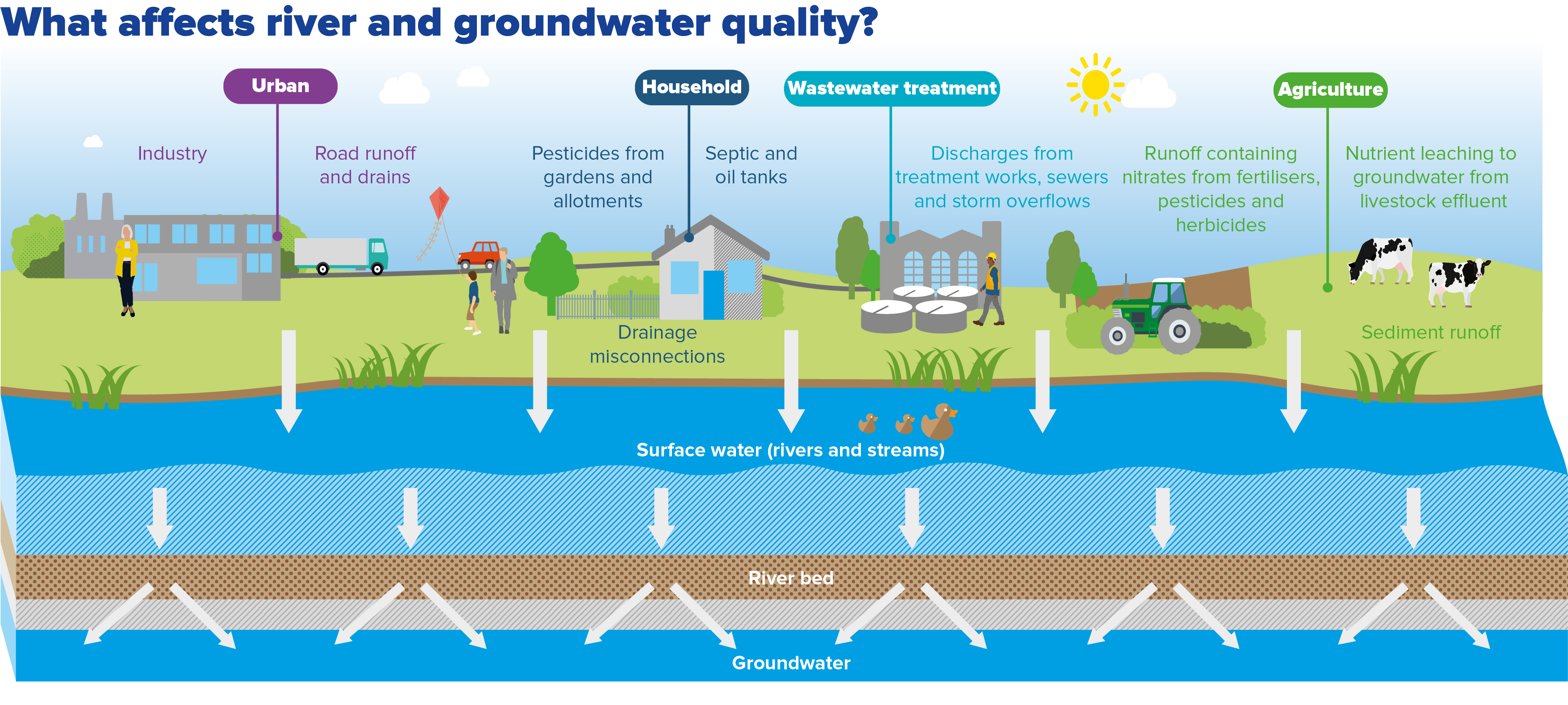Catchment challenges we need to solve
Our catchments, whether they are rivers, seas or underground aquifers, are affected by everyone and everything using them.


There are a number of key challenges that we are currently working to tackle via a collaborative catchment-based approach.
Nitrate
High nitrate levels in rivers or groundwater may come from a number of sources – fertiliser applications, old or poorly maintained septic tanks, leaking sewers, wastewater discharges and manure storage and spreading.
At high levels, nitrate affects estuaries and coastal waters by causing large amounts of algae to grow. This reduces the amount of oxygen in the water which impacts aquatic plants and wildlife.
There are also standards for the level of nitrate allowed in drinking water. Two thirds of our groundwater sources show high or increasing levels of nitrate, which need to be reduced to meet acceptable these standards. We can do this by adding additional treatment or diluting the concentration by mixing water with supplies from another source with lower levels. Either way, this involves ‘building’ a solution which is expensive, energy intensive, and not sustainable in long term.
So alongside these solutions, we’re working with our partners to address the sources of nitrate in our catchments. This means we are protecting both our drinking water sources and the natural environment for the future. It can take decades for water to seep down into aquifers and the current levels of nitrate are from fertiliser used many years ago. This makes it even more important to take action now to prevent greater problems in the future, which is why we are committing to a long term catchment management programme.
Pesticides
Pesticides are widely used to control pests, weeds and plant disease. We have treatment in place to remove pesticides from water. However there are a number of pesticides which are difficult to remove from water. Metaldehyde, which is used in gardens, on allotments, and by farmers to control slugs and snails, is one of the most challenging pesticides for water companies to remove.
It’s very easily carried from land to nearby streams and rivers when it rains and we have recorded levels of this pesticide above the drinking water standard in two thirds of our rivers and reservoirs.
As we are unable to remove metaldehyde completely via existing treatment technology, our only option is to address the sources of metaldehyde.
There are a number of other pesticides of concern, because we detect them at very high levels in river water, which can make them difficult to remove entirely. These include the weed-killers propyzamide and carbetamide, widely used on commercial oilseed rape crops.
Pollution incidents
As well as the key challenges posed by nitrate and pesticides, we need to be ready to deal with any pollution incidents which have the potential to pose a risk to drinking water quality. We work in our catchments identifying and addressing potential hazards to try to prevent pollution incidents from occurring.
Obstacles which slow river flows
The flow of rivers is affected by the introduction of physical features such as weirs, sluices and modified banks which can affect water quality and quantity. These can make rivers less able to cope with extreme weather, such as droughts and floods, and they also stop wildlife, especially fish, from moving freely.
Phosphorus
Phosphorus is a naturally-occurring nutrient usually found in streams and rivers but in large amounts it causes pollution. It disrupts habitats by feeding algae and creating ‘algal blooms’ which smother other plants and use up oxygen – suffocating insects and fish.
The main sources of phosphorus are wastewater discharges and fertiliser usage on farmland.
Future challenges
As well as addressing current water quality issues, we need to make sure we are ready to meet future challenges that might affect the quality and amount of water available.
Leaving the European Union could lead to changes in farming, such as an increase in the amount of wheat and oil seed rape grown, or in livestock farming.
The effects of climate change and changing weather could also influence the choice of crops grown and the pesticides farmers use. Climate change is also having an impact on water availability.
Sustainable water environments
The Water Framework Directive 2000/60/EC is an European Union directive which commits EU member states to achieve good ecological status and prevent deterioration of the status of designated water bodies. The no deterioration element assesses the impact of any increased abstraction on the environment and/or ecology at a water body scale. Any drop in statues of the water body will result in the requirement for mitigation measures to make the water environment more sustainable such as abstraction licence reduction, river restoration etc.
Catchment First – a unique opportunity
Catchment First provides a unique opportunity to work collaboratively to change the way we interact with the environment and solve these challenges. It also gives us an opportunity to innovate, by trying new approaches to meet our regulatory obligations in a more efficient way. By adopting a Catchment First approach in our longer-term plans, such as our 50-year Water Resource Management Plan, we’re able to take a much longer-term view of how we can deliver more natural solutions to address the challenges we face.
"There are great opportunities to employ catchment management approaches which often offer wider benefits than traditional measures."
John Spence, Chairman, Arun & Western Streams Catchment Partnership